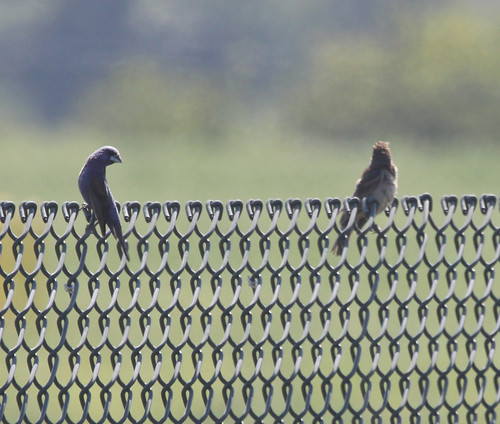Celebrate Urban Birds hosts Latino youths for informal summit
Updated: 2012-08-28 19:16:15
 “It feels so fragile!” said Alexis, cupping a tiny Song Sparrow in her hands for the first time. On a hot, sunny August day, Alexis and two dozen other teens were visiting the Cornell Lab as part of an informal summit of Latino youth. Hosted by the Lab’s Celebrate Urban Birds project, the trip capped [...]
“It feels so fragile!” said Alexis, cupping a tiny Song Sparrow in her hands for the first time. On a hot, sunny August day, Alexis and two dozen other teens were visiting the Cornell Lab as part of an informal summit of Latino youth. Hosted by the Lab’s Celebrate Urban Birds project, the trip capped [...]
 Eastern Wood-Pewee – Pro Bug-eater! If you love birds and butterflies – why not give moths a try? The Ohio Birdfreaks took on the night life by attending a Mothing event at the Black Swamp Bird Observatory (BSBO) led by Kenn Kaufman. The BSBO joined the Toledo Naturalists’ Association (TNA) to help us learn how [...]
Eastern Wood-Pewee – Pro Bug-eater! If you love birds and butterflies – why not give moths a try? The Ohio Birdfreaks took on the night life by attending a Mothing event at the Black Swamp Bird Observatory (BSBO) led by Kenn Kaufman. The BSBO joined the Toledo Naturalists’ Association (TNA) to help us learn how [...] Writing intern Abby McBride explores the caged bird industry with help from Cornell Lab scientist Eduardo Iñigo-Elias, who coordinates our Neotropical Bird Conservation Initiative. Here’s Abby: Environmental crime officials cracked down on wildlife trafficking between Latin America and Europe this summer, seizing more than 8,700 contraband animals in an Interpol bust dubbed Operation Cage. Authorities arrested [...]
Writing intern Abby McBride explores the caged bird industry with help from Cornell Lab scientist Eduardo Iñigo-Elias, who coordinates our Neotropical Bird Conservation Initiative. Here’s Abby: Environmental crime officials cracked down on wildlife trafficking between Latin America and Europe this summer, seizing more than 8,700 contraband animals in an Interpol bust dubbed Operation Cage. Authorities arrested [...] Thanks to a fellow birder’s discovery, I made my way to a small nature preserve that I never had even heard of called Bell Bowl. This preserve is on the Rockford/Chicago International Airport’s property but is open to the public. So I made my way down a nondescript road to the preserve. Hanging around the [...]
Thanks to a fellow birder’s discovery, I made my way to a small nature preserve that I never had even heard of called Bell Bowl. This preserve is on the Rockford/Chicago International Airport’s property but is open to the public. So I made my way down a nondescript road to the preserve. Hanging around the [...] : Craig's Bird Watching and Nature Blog Pages Home Bird Pictures Butterfly Pictures Bee Pictures Wild Animal Pictures My Life List Hire Craig Saturday , August 18, 2012 Six-Lined Racerunner Six-lined racerunners have six light blue to yellow lines running the length of their body . Males have a pale blue belly and throat . The hind feet are much longer than the front and the fourth toe on the hind foot is extremely long . They can be up to 12 in 30 cm . long This lizard lives in open , dry grasslands and sandy areas . Six-lined racerunners are very fast and can outrun most humans attempting to catch them . However , when you see one of these active , alert lizards , you can usually watch it if you don’t get too close . These lizards rarely climb and often take refuge in burrows if
: Craig's Bird Watching and Nature Blog Pages Home Bird Pictures Butterfly Pictures Bee Pictures Wild Animal Pictures My Life List Hire Craig Saturday , August 18, 2012 Six-Lined Racerunner Six-lined racerunners have six light blue to yellow lines running the length of their body . Males have a pale blue belly and throat . The hind feet are much longer than the front and the fourth toe on the hind foot is extremely long . They can be up to 12 in 30 cm . long This lizard lives in open , dry grasslands and sandy areas . Six-lined racerunners are very fast and can outrun most humans attempting to catch them . However , when you see one of these active , alert lizards , you can usually watch it if you don’t get too close . These lizards rarely climb and often take refuge in burrows if It’s an exciting time to be in field biology—the naturalists of today have more tools at their disposal than ever before. To learn how to use those tools, a group of Cornell students have been spending this summer in the field; and Abby McBride, a summer writing intern, accompanied them in the field to write the [...]
It’s an exciting time to be in field biology—the naturalists of today have more tools at their disposal than ever before. To learn how to use those tools, a group of Cornell students have been spending this summer in the field; and Abby McBride, a summer writing intern, accompanied them in the field to write the [...] A Great Egret taking off at Horicon Marsh in Wisconsin. And here’s a landing
A Great Egret taking off at Horicon Marsh in Wisconsin. And here’s a landing